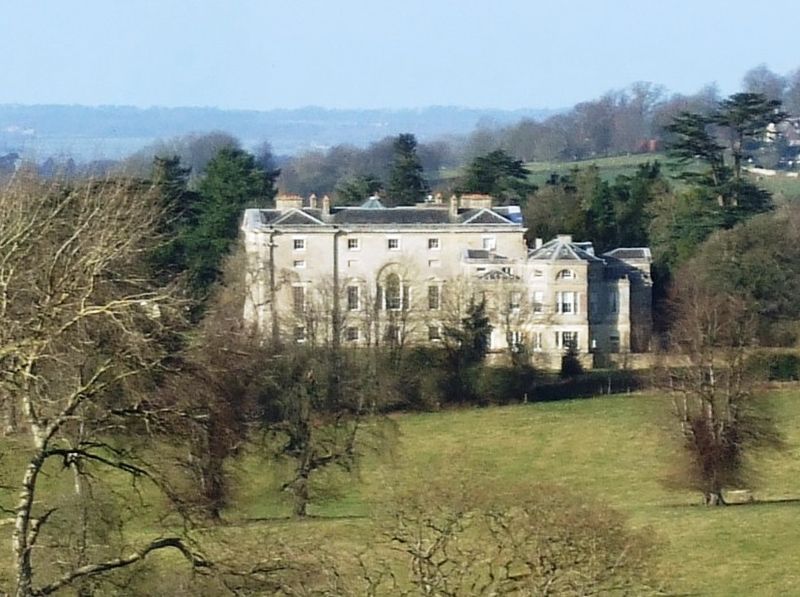In SS Gregory & Augustine, Oxford, accompanied by chant (of course) and some really good polyphony too, with Aidan Nichols preaching.
An initiative of Fr John Saward, Priest in Charge of SS Gregory & Augustine's.
Labels
- Bishops
- Chant
- Children
- Clerical abuse
- Conservative critics of the EF
- Correctio Filialis
- FIUV Position Papers
- Fashion
- Freemasonry
- Historical and Liturgical Issues
- Islam
- Liberal critics of the EF
- Marriage & Divorce
- Masculinity
- New Age
- Patriarchy
- Pilgrimages
- Pope Francis
- Pro-Life
- Reform of the Reform
- Young people
Saturday, September 29, 2012
Friday, September 28, 2012
Rosary Crusade of Reparation in London, 13th Oct
This sadly but unavoidably clashes with the Aylesford Pilgrimage, and even I can't be in two places at once. But I heartily recommend the Rosary Crusade, which is one of the most impressive Catholic acts of witness in the country each year.
Rosary Crusade of Reparation on
Saturday 13 October 2012, Westminster.
Starts at 1.45pm outside Westminster Cathedral. Walk in procession to the Brompton Oratory.
More info on http://
Successful LMS Pilgrimage to Lourdes
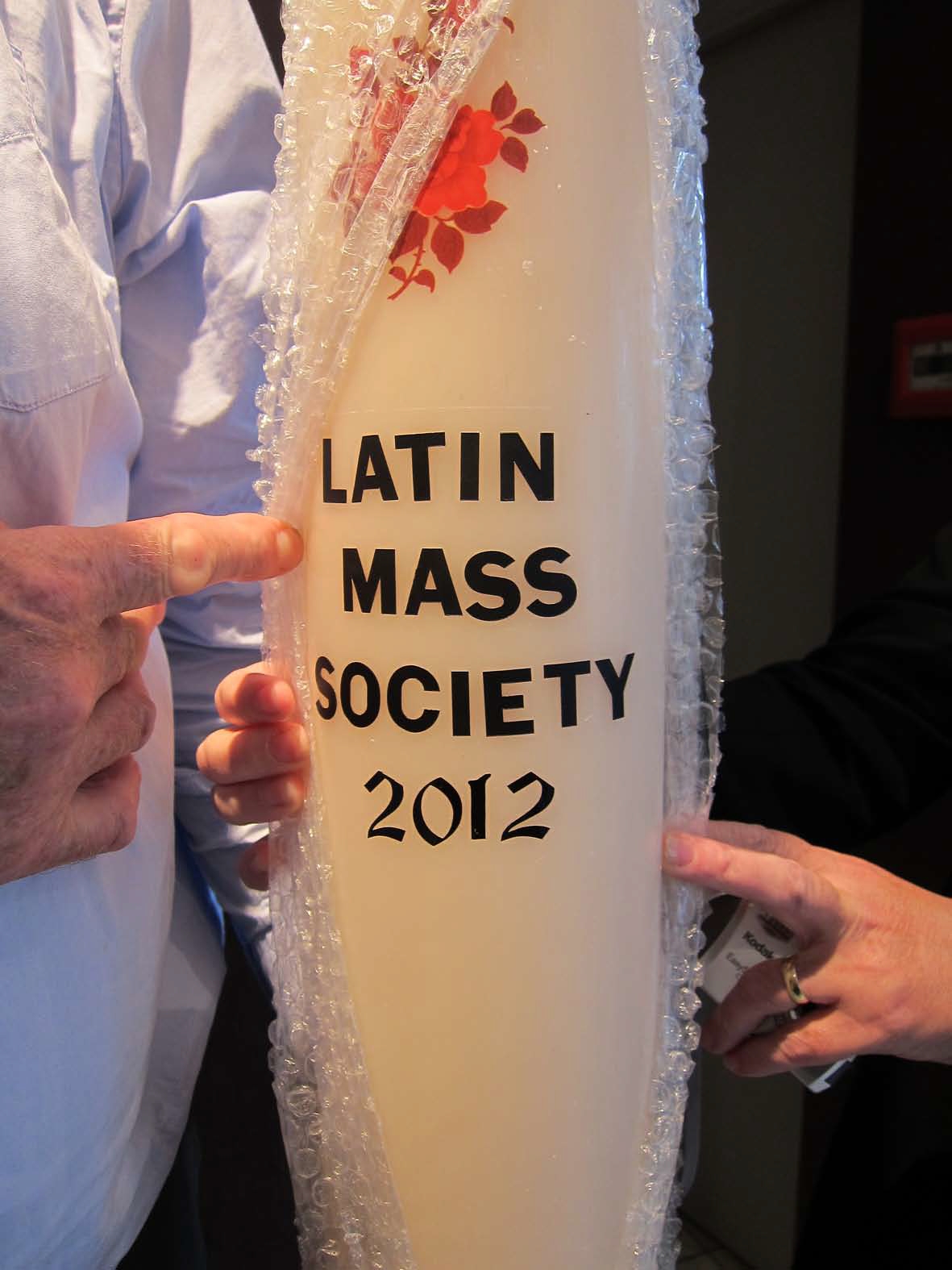 The LMS has had groups going to Lourdes before, but this was the first time we've attempted a pilgrimage, in accordance with Our Lady's specific request, 'with the sick'. Pilgrimages with the sick - which can mean a very wide range of things, from mild but chronic illness or disability, to the most serious issues which only pilgrimages with a high level of medical expertise can deal with - add a whole new dimension to the usual pilgrimage experience.
The LMS has had groups going to Lourdes before, but this was the first time we've attempted a pilgrimage, in accordance with Our Lady's specific request, 'with the sick'. Pilgrimages with the sick - which can mean a very wide range of things, from mild but chronic illness or disability, to the most serious issues which only pilgrimages with a high level of medical expertise can deal with - add a whole new dimension to the usual pilgrimage experience.
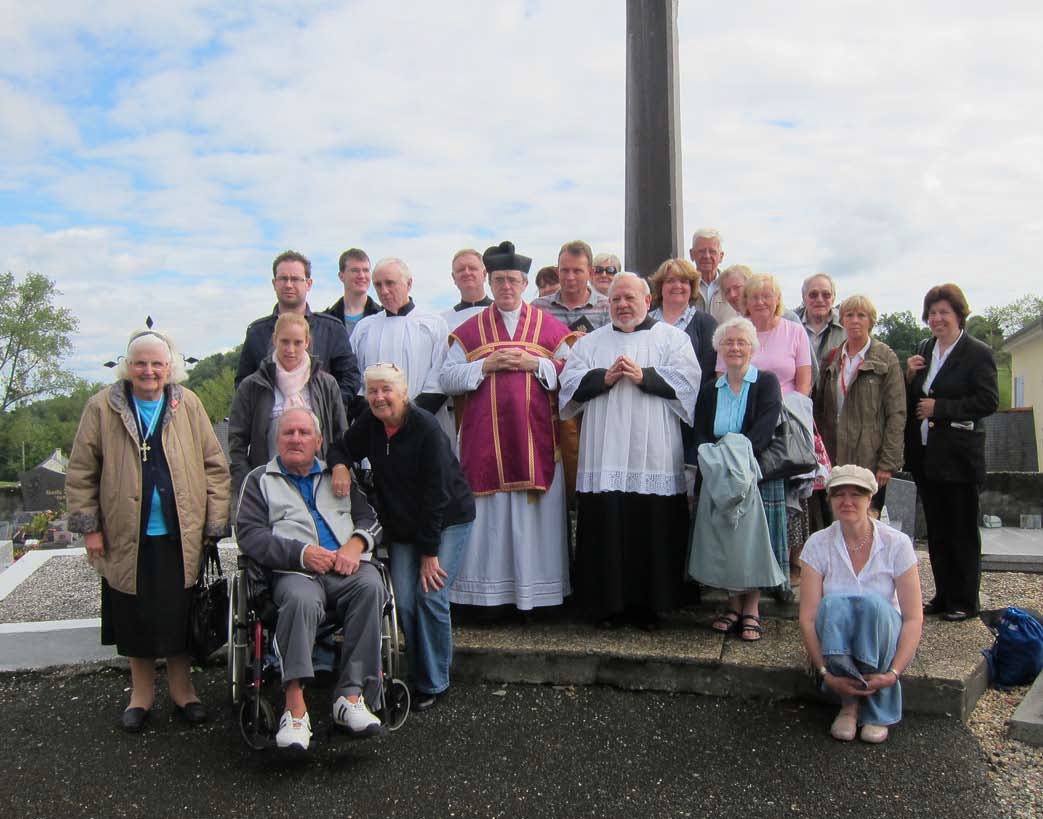
Our pilgrims have established a good precedent for future pilgrimages, and I hope this pilgrimage will grow and flourish. This year it was attended by 23 pilgrims, with Fr Michael Brown, LMS Regional Chaplain for the North. There are reports here, here, and here, and more photos here.
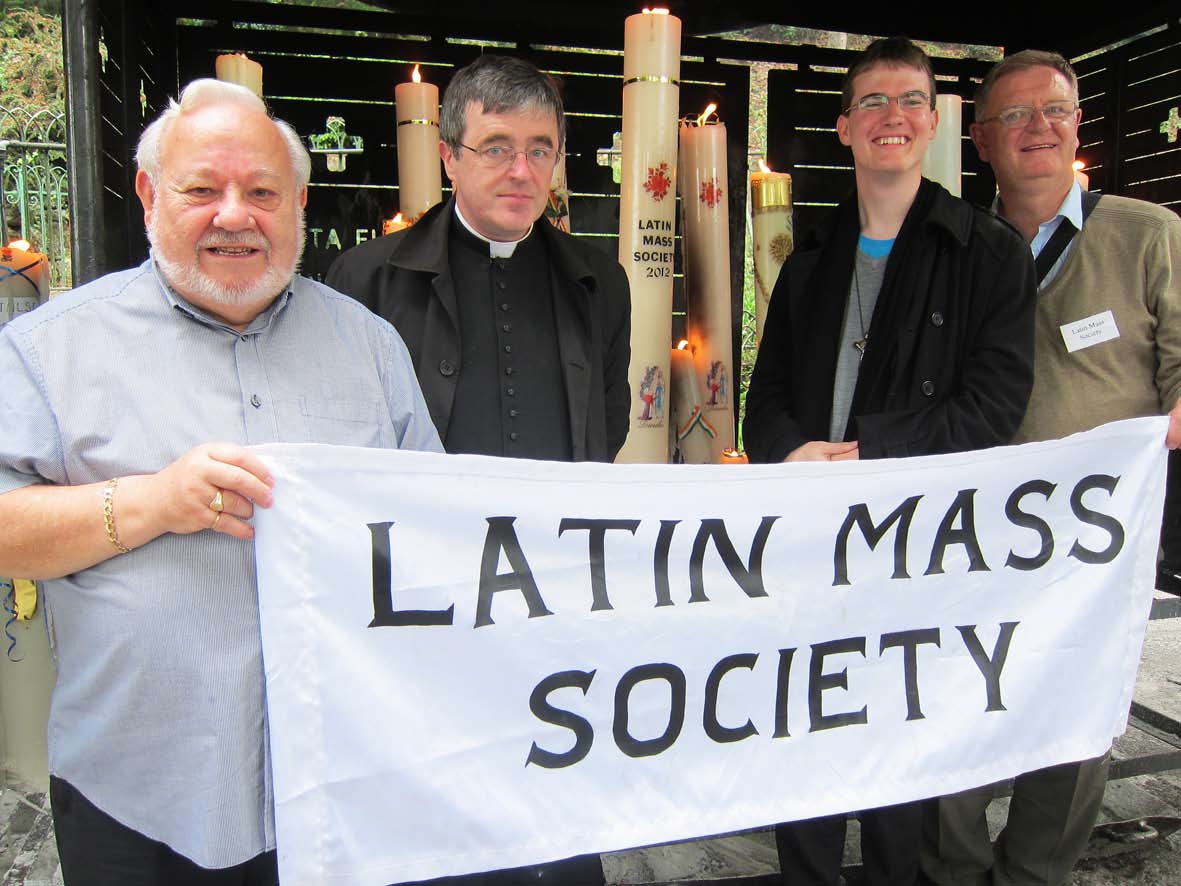
Wednesday, September 26, 2012
More Hildebrand on the Requiem
 |
| Bishop Hopes blessing the catafalque at the LMS Annual Requiem |
'Thus the Alleluia and the elimination of black vestments in the Requiem not only ignores the human aspect of death, but also distorts the supernatural perspective on death. The death of a man is the moment of judgement, it is the great and fearful encounter with the divine Judge. Although death is transfigured by hope - hope for our dead beloved one, and for all who loved him and mourn for him - this hope does not take away ultimate seriousness and holy fear. It is simply not the right form for the Mass for the Dead when this Mass gives the impression of celebrating the entrance of the deceased into eternal blessedness. ...
'The optimism of the new Mass for the Dead, as well as its tendency to introduce a harmless note into the theme of the judgement of God (there was none of this in the Tridentine Requiem) is deeply related to this-worldliness, and to a loss of a sense of the supernatural.'
Dietrich von Hildebrand, 'The Devastated Vineyard'. pp224-5
See my extracts from this book, on grief, and on truth and the via media.
Tuesday, September 25, 2012
Dominican Rite Low Mass booklet: corrected
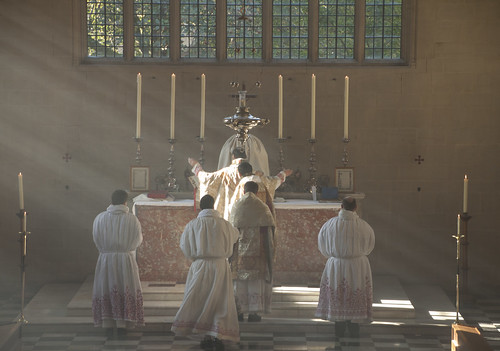
The Dominican Rite Low Mass pdf which has been available on a couple of websites had a number of typos in it, including the omission of Anastasia from the Canon. It has now been corrected and is available from David Forster's Liturgia Latina site.
The typos came to light in preparing a booklet for last year's, and then this year's, Oxford Pilgrimage, which includes a Solemn Mass in the Domincan Rite in Blackfriars, Oxford. The differences between Low and Solemn Mass are also quite confusing. Since few people have a Dominian Rite hand missal, I thought it best to create a booklet with all the prayers of the Mass, Ordinary and Propers, so people can follow it as easily as possible.

Do come along this year! It is taking place on
Saturday 20th October,
with Mass at 11am, and
a Procession to one of Oxford's sites of martyrdom at 2pm, followed by Benediction.
Sunday, September 23, 2012
LMS Pilgrimage to Aylesford, 13th October
 Latin Mass Society Pilgrimage to Aylesford, the shrine of Our Lady of Mount Carmel, the home of the Brown Scapular.
Latin Mass Society Pilgrimage to Aylesford, the shrine of Our Lady of Mount Carmel, the home of the Brown Scapular. Saturday 12th October, Sung or Solemn Mass at 1.30pm, celebrated by Fr Tim Finigan in the Relic Chapel
Coach from London: booking required. info@lms.org.uk; 020 7404 7284
I'll be driving from Oxford, please email me if you want a lift from there: joseph.shaw@philosophy.ox.ac.uk
Please bring your own picnic lunch
Programme:
Confessions from 12:45pm
1:30pm Mass
3pm Spiritual talk
4pm Tea / coffee
4.30pm Rosary and Benediction

Music for Mass will be polyphonic, provided by Cantus Magnus.
John Taverner (c.1490–1545)
Kyrie 'Leroy'
Mass 'The Western Wynde'
Thomas Tallis (c.1505–1585)
Bone pastor
William Byrd (c.1540–1623)
Ego sum panis vivus
Aylesford, an ancient Carmelite house re-established in modern times, is a remarkable place, and this pilgrimage is highly recommended. See my report from last year, and more photos.
To get to Aylesford Priory (‘The Friars’) from the M20, leave at Junction 5, drive SOUTH and turn right onto the A20, right again onto Halls Road to Aylesford. Drive through Aylesford and follow the signs.
View Larger Map
Saturday, September 22, 2012
Mass in St Peter's 3 Nov 3pm
STATEMENT.
Following the press conference of 10th September, the Coetus Internationalis pro Summorum Pontificum wishes to announce a change of time for the Mass in the Extraordinary Form of the Roman Rite. The Mass will now take place in St. Peter's Basilica at 3 p.m. in the afternoon of Saturday 3rd November.
This change has been made to facilitate the celebration of the annual Mass for deceased members of the Sacred College of Cardinals by the Holy Father that morning. We are one with the Holy Father and we accept without question this change of time.
The International Federation Una Voce will be organising Masses and other events in Rome on 1st and 2nd November and all pilgrims are invited to participate.
Details of these events, together with details of all Masses in the Extraordinary Form in the City of Rome during the time of the pilgrimage, will be released on the official website of the Pilgrimage http://unacumpapanostro.wordpress.com and the official website of the International Federation Una Voce http://fiuv.org by early October.
The Coetus Internationalis pro Summorum Pontificum invites all the faithful attached to the Extraordinary Form of the Roman Rite to double their efforts to show their support for the Holy Father and his document Summorum Pontificum.
The Coetus Internationalis pro Summorum Pontificum invites all the faithful coming to Rome and those who can not come to join the Holy Father in prayer for the souls of the deceased Cardinals.
Contact: Secretary of CISP: orga.cisp@mail.com
Official Spokesman of the Pilgrimage: secretary@fiuv.org
Following the press conference of 10th September, the Coetus Internationalis pro Summorum Pontificum wishes to announce a change of time for the Mass in the Extraordinary Form of the Roman Rite. The Mass will now take place in St. Peter's Basilica at 3 p.m. in the afternoon of Saturday 3rd November.
This change has been made to facilitate the celebration of the annual Mass for deceased members of the Sacred College of Cardinals by the Holy Father that morning. We are one with the Holy Father and we accept without question this change of time.
The International Federation Una Voce will be organising Masses and other events in Rome on 1st and 2nd November and all pilgrims are invited to participate.
Details of these events, together with details of all Masses in the Extraordinary Form in the City of Rome during the time of the pilgrimage, will be released on the official website of the Pilgrimage http://unacumpapanostro.wordpress.com and the official website of the International Federation Una Voce http://fiuv.org by early October.
The Coetus Internationalis pro Summorum Pontificum invites all the faithful attached to the Extraordinary Form of the Roman Rite to double their efforts to show their support for the Holy Father and his document Summorum Pontificum.
The Coetus Internationalis pro Summorum Pontificum invites all the faithful coming to Rome and those who can not come to join the Holy Father in prayer for the souls of the deceased Cardinals.
Contact: Secretary of CISP: orga.cisp@mail.com
Official Spokesman of the Pilgrimage: secretary@fiuv.org
Friday, September 21, 2012
History: and a Conference on Medieval Worship
Before I was a philosopher I was a historian. I did a year of 'Modern History' in Oxford, before switching subjects, in the sense of 'modern' which starts in the year 363 because it was then that the Emperor Diocletian first divided the Roman Empire into Western and Eastern parts, and well, the rest is just history. Looking at the recent history of the liturgy makes one understand the importance of history as a discipline, because the various progressives and reformers of the 20th Century were enormously influenced by what they thought they knew about the past. Their understanding of the ancient and medieval Church was a profoundly important part of their self-understanding. Their understanding of what worked, or should have worked, in the past, and mistakes which were made in the past, directly affected what they proposed for the present. And of course their desires about what should happen now affected how they interpreted the historical evidence, so arguments about history often turned into arguments about the present.
There are people both among the progressives and (strangely, but truly) among trads, who want to ignore history altogether, and live as if the world came into existence five minutes ago. That is incompatible with the Christian revelation, because the Incarnation was a historical event and revelation took place historically, over time, and using historical documents. Ignorance of history in practice also allows your opponents to walk all over you with their historically-based arguments, however bad they might be, and that is a pretty terrible idea. Catholics should learn about the history of the Church, they should read the lives of the saints, they should familiarise themselves with the monuments of past ages, buildings, art, books, and be able to place them into a realistic historical context.
One of the most closely-fought areas of discussion is the Middle Ages. The Catholic progressives helped themselves to a Protestant argument that the Middle Ages were bad in every possible way, in order to argue that the liturgical forms, and forms of liturgical participation by the faithful, which developed during that period should be thoroughly rejected. They again helped themselves to a Protestant argument that everything was quite different, and wonderful, in an earlier period of the Church. The scholarship of the last half century, which has been less driven than that of earlier decades by a Protestant agenda (because professional historians in the English-speaking world no longer overwhelmingly accept some form of Protestantism), has undermined both arguments. It is now accepted that there is a great deal of continuity of ethos between ancient and medieval worship - the mystery, the keeping of holy things for the holy, the separation of nave and sanctuary - and medieval worship was genuinely popular, it was not irrelevant to popular piety, people took a close interest in it and lamented its disappearance at the Reformation.
A lot of very interesting work has been done recently on Medieval worship at Bangor University, and they are having a conference about it Saturday 6th October. Go to the Gregorian Chant Network blog for more info.
There are people both among the progressives and (strangely, but truly) among trads, who want to ignore history altogether, and live as if the world came into existence five minutes ago. That is incompatible with the Christian revelation, because the Incarnation was a historical event and revelation took place historically, over time, and using historical documents. Ignorance of history in practice also allows your opponents to walk all over you with their historically-based arguments, however bad they might be, and that is a pretty terrible idea. Catholics should learn about the history of the Church, they should read the lives of the saints, they should familiarise themselves with the monuments of past ages, buildings, art, books, and be able to place them into a realistic historical context.
One of the most closely-fought areas of discussion is the Middle Ages. The Catholic progressives helped themselves to a Protestant argument that the Middle Ages were bad in every possible way, in order to argue that the liturgical forms, and forms of liturgical participation by the faithful, which developed during that period should be thoroughly rejected. They again helped themselves to a Protestant argument that everything was quite different, and wonderful, in an earlier period of the Church. The scholarship of the last half century, which has been less driven than that of earlier decades by a Protestant agenda (because professional historians in the English-speaking world no longer overwhelmingly accept some form of Protestantism), has undermined both arguments. It is now accepted that there is a great deal of continuity of ethos between ancient and medieval worship - the mystery, the keeping of holy things for the holy, the separation of nave and sanctuary - and medieval worship was genuinely popular, it was not irrelevant to popular piety, people took a close interest in it and lamented its disappearance at the Reformation.
A lot of very interesting work has been done recently on Medieval worship at Bangor University, and they are having a conference about it Saturday 6th October. Go to the Gregorian Chant Network blog for more info.
Wednesday, September 19, 2012
Mass in Wardour
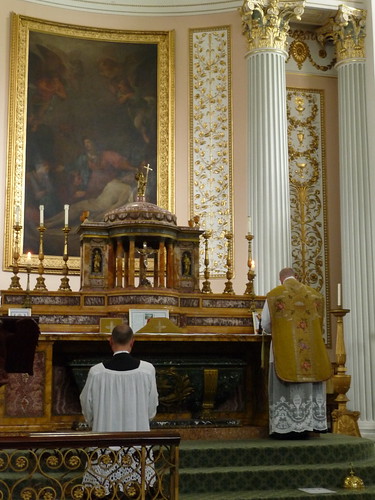 I am still working through stuff I missed over the Summer, and this is an event I would very much have liked to attend: one of the Latin Mass Society's regular Masses in the private chapel of New Wardour Castle, one of the great historic Catholic houses of England.
I am still working through stuff I missed over the Summer, and this is an event I would very much have liked to attend: one of the Latin Mass Society's regular Masses in the private chapel of New Wardour Castle, one of the great historic Catholic houses of England. Low Mass was celebrated by Fr Bede Rowe on 21st August.
Keep an eye on the LMS Clifton blog to find out when the next one will be.
Monday, September 17, 2012
Solemn Mass for Year of Faith
There will be a Solemn Mass in SS Gregory & Augustine's, Oxford, on the feast of the Motherhood of Our Lady, Thursday 11th October at 6 p.m., to celebrate the opening of the Year of Faith. The preacher will be Fr Aidan Nichols OP. The intention of the Mass will be the Holy Father.
- Posted using BlogPress from my iPhone
- Posted using BlogPress from my iPhone
Saturday, September 15, 2012
FIUV Position Paper on Western Culture
 |
| Agatha Christie |
There were also arguments that changes to the liturgy needed to made for the sake of the Missions, and I hope we'll be able to follow this paper up with papers on other cultures.
As an appendix to this paper we have included the LMS Petition to Pope Paul VI of 1971, when it looked as though the ancient Mass would simply be banned. The signatures Alfred Marnau, my predecessor as Chairman of the Latin Mass Society, who organised it, was able to gather are astounding. I don't know how many were familiar in the curia, but it must have impressed people in the UK. The Duke of Norfolk, the Poet Laureate, the Controller of Music at the BBC, the Editor of The Times, the Master of Music at Westminster Cathedral, politicians from all the main parties, and a host of musicians, scholars and novelists signed the petition. In a short list - 56 names - Marnau managed to include a staggering range of interests and bagged a high proportion of the most important cultural figures of the day, not only in Britain, but from across Europe.
 |
| Yehudi Henuhin |
I have heard this petition criticised because of its inclusion of non-Catholics. That, of course, was the point of it. Having just, in its wisdom, promulgated the Novus Ordo Missae for the good of souls, the curia wasn't about to accept the argument that the ancient Mass had to be preserved for the good of souls, made by a bunch of laymen, who were't even liturgical scholars. At that moment, another argument had to be used, and I think it was a stroke of genius on Marnau's part that he appealed to its cultural importance. He was able to gather the support of people who were appalled by the vandalism being carried out in the Catholic Church, even from outside the Church. The recognition of the cultural value of the ancient liturgy, art, and literature of the Church is the tribute rightly paid by the cultural elite to the truth of the Gospel, even when they can't bring themselves to accept the truth in full. As a matter of fact, among the signatories were many prominent Catholics, many converts, and some, like Lord (Kenneth) Clark, who became Catholics later.
 |
| Sir Ralph Richardson |
The recongnition of the cultural value of the ancient Mass by non-Catholics who have taken the trouble to think about it actually undermines one of the central arguments against: that the Mass does not appeal to 'modern man'. There can be few causes which could unite, on one petition, the ferociously right-wing Monday Club member and Tory MP, Sir Patrick Wall, a paid-up Communist, Theodore Toynbee, and a British spy turned expert on Zoroastrianism, Robert Zaehner? Or the literary critic F.R. Leavis, with the novellists Agatha Christie, Nancy Mitford, Robert Graves and Graham Greene? Not to mention Harold Acton, Vladimir Ashkenazy, Malcom Muggeridge, Ralph Richardson, Iris Murdoch, Yehudi Menuhin, and Lennox Berkely.
Alfred Marnau's account of the petition, and its reception, is available on the LMS website here,
Thursday, September 13, 2012
Resources for the Traditional Mass
Printable copies of the music and propers for various Masses have been made available here; they were originally developed for John Fisher House, the Cambridge Chaplaincy. They include some interesting features, such as the Offertory Verses. These verses, to which the Offertory Antiphon is the antiphon, are theologically rich and musically and poetically very interesting. The Schola Abelis in Oxford frequently sings them; they are sung by a cantor, and at the end of verses the full schola repeats all or part of the antiphon. They are not for the faint-hearted, however, as they are difficult. They are optional in the Extraordinary Form, which is to say (as far as I can work it out) they are not in the Missal, so there is no obligation to sing them, but as it is permissible (and there is usually time) to sing extra things at the Offertory, nothing more appropriate can be imagined than the original verses which go with the Offertory Antiphon in the medieval manuscripts (this was made explicit bty Musica Sacra in 1958). An edition of the music for these verses, produced originally in 1935, is available on the Catholic Music Association of America site here (big pdf).
Offertory Confirma hoc, for Pentecost, with the ancient verses, sung by the Schola Abelis.
Those choirs which sing these Offertory verses may well want to provide the congregation with the text, and a translation, which is provided in these sheets.
Offertory Confirma hoc, for Pentecost, with the ancient verses, sung by the Schola Abelis.
Those choirs which sing these Offertory verses may well want to provide the congregation with the text, and a translation, which is provided in these sheets.
Wednesday, September 12, 2012
Forty Days for Life: now in Oxford too
http://40daysforlife.com/oxford/
This autumn, from September 26 - November 4, our community will be one of many cities joining together for the largest and longest coordinated pro-life mobilization in history -- the 40 Days for Life campaign.
- Posted using BlogPress from my iPhone
This autumn, from September 26 - November 4, our community will be one of many cities joining together for the largest and longest coordinated pro-life mobilization in history -- the 40 Days for Life campaign.
- Posted using BlogPress from my iPhone
Tuesday, September 11, 2012
'Friends of Lanherne' launched
I blogged some time ago on the predicament of the Sisters of the Immaculate at Lanherne in Cornwall. They have for ten years been living in a convent owned by the Carmelites, who had moved out. The sisters use the 1962 Missal for Mass and the 1962 Office. And they look the part. There's some more information about their way of life on the New Liturgical Movement. See where it is on a map.
The Carmelites now want to sell the property. The Sisters of the Immaculate cannot own property, however, and have no money. So some lay supporters have now set up a charitable trust for this purpose: registered charity 1146207.
There is now a Friends of Lanherne blog: www.friendsoflanherne.org
It is possible to donate to them online (credit card or Paypal) through the Charities Aid Foundation.
Or write to:
Friends of Lanherne,
69 Derwent Drive,
Purley,
Surrey, CR8 1ES
Email: info@acharlton.f9.co.uk.
The Carmelites now want to sell the property. The Sisters of the Immaculate cannot own property, however, and have no money. So some lay supporters have now set up a charitable trust for this purpose: registered charity 1146207.
There is now a Friends of Lanherne blog: www.friendsoflanherne.org
It is possible to donate to them online (credit card or Paypal) through the Charities Aid Foundation.
Or write to:
Friends of Lanherne,
69 Derwent Drive,
Purley,
Surrey, CR8 1ES
Email: info@acharlton.f9.co.uk.
Monday, September 10, 2012
Walsingham: call for volunteers
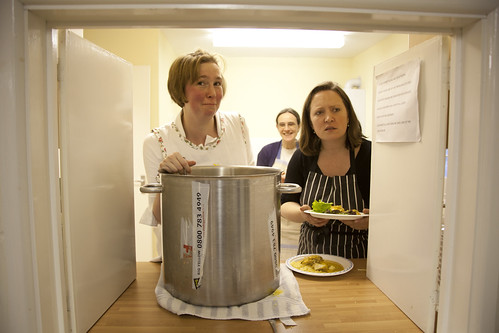
This year's Pilgrimage to Walsingham was possible due to the great efforts of two, overlapping groups of people who were mainly in the background in all the photos I took: the people who planned the thing in advance, and the people who didn't walk with us but drove cars and vans, cooked, washed up, looked after those who dropped out and so on. With a total of over 70 people you need a very significant support team, people who are doing nothing else. If, as we expect, it continues to grow, this is going to become an even more important part of the pilgrimage next year.
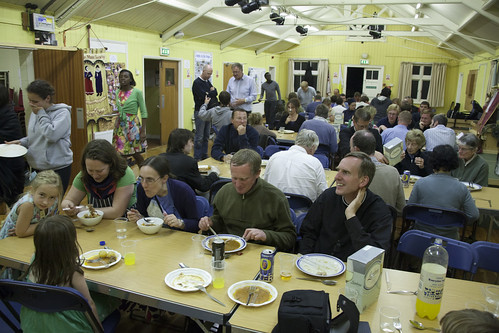
So please let us know if you can help! We particularly need people for the catering team; a few first-aiders would also be much appreciated, and people with experience of driving minibuses. On the catering side experience of catering is a plus: cooking for 100 people is a very different experience from cooking for 10. But what is most important is a willingness to work in a team for the glory of God and for the benefit of our fellow Catholics, those zealous souls walking the pilgrimage. Without wishing to put people off, I would say that it is no sacrifice of one's opportunities for penance to work in the support side rather than walk the pilgrimage. It is a different, but entirely necessary, contribution to the great, corporate good work which the LMS Pilgrimage to Walsingham represents.
So get in touch with the LMS: email info@lms.org.uk
To book as a pilgrim for next year, at this year's rates, go the LMS Website and take advantage of the Early Bird offer. The dates for 2013 will be the equivalent of this year's, i.e. the bank holiday weekend: Friday 22nd to Sunday 25th August 2013.
Saturday, September 08, 2012
More about the Walsingham Pilgrimage, Part 2
To book for next year, at this year's rates, go the LMS Website and take advantage of the Early Bird offer. The dates for 2013 will be the equivalent of this year's, i.e. the bank holiday weekend: Friday 22nd to Sunday 25th August 2013.
Continued from the previous post.
On the second day we had the worst weather. Blimey, did it rain. But the storm passed.

On the third day, the shortest, we were joined by two newcomers: Canon Meney, who'd not been able to join us until then, and the processional statue of Our Lady of Walsingham, which had her first outing at the LMS Oxford Pilgrimage last October.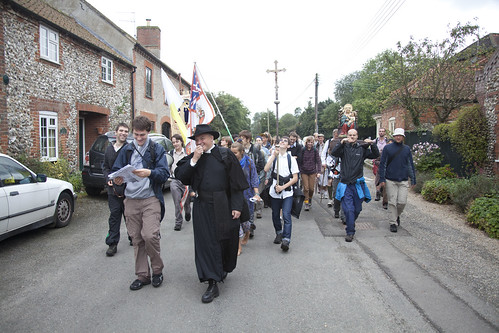
Carrying the statue on its bier was an experiment; it needs some adjustments ideally, but we did carry it all the way from Harpley to the Slipper Chapel, and then to the site of the Holy House. It is weatherproof, I'm glad to say.
We were all kept in order by Paul Smeaton, the indefatigable route-planner and chief marshall.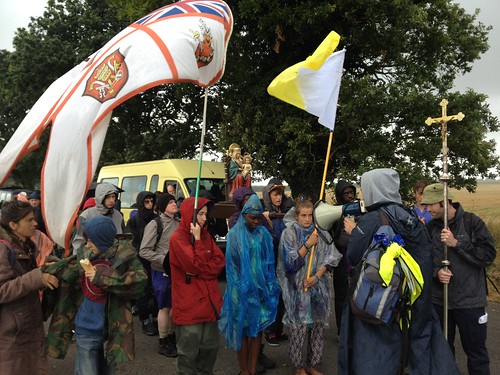
At the Solemn Mass in Walsingham, where the extraordinary lights turn everything bright yellow, we were joined not only by Bishop Davies, who preached, but by Fr Mark Withoos, who happened to be in this part of the country. Fr Withoos, who is also a great supporter of the Chartres Pilgrimage and was one of the chaplains this year, works in the Pontifical Council Ecclesia Dei. He was in choir, and joined the procession to the Abbey grounds after Mass.
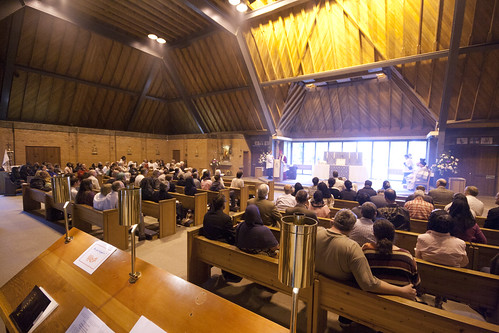
There was room for a few more in the church, but it was pretty full: the fullest it has been for the LMS Pilgrimage for a long time, if not ever. As well as a coach coming from London, many people made the trip to the Solemn Mass and procession by car.
And that was quite a procession, singing the Rosary, with the statue and our banners, many pilgrims barefoot.
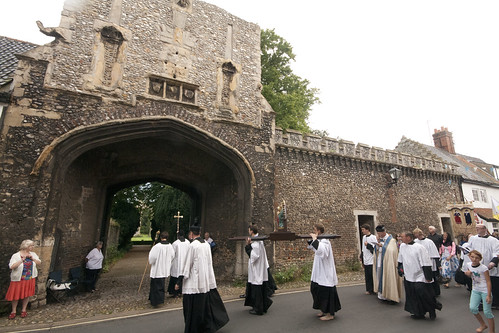
Into the Abbey grounds...
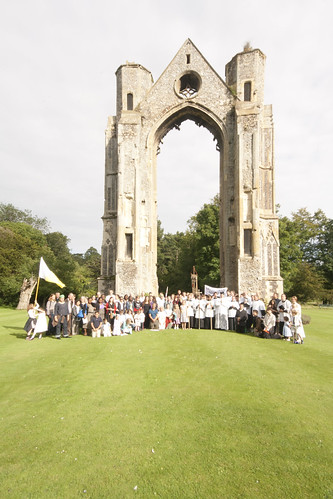
And after the final blessing by our chaplain, Fr Bede Rowe, the survivors' photo.
Continued from the previous post.
On the second day we had the worst weather. Blimey, did it rain. But the storm passed.

On the third day, the shortest, we were joined by two newcomers: Canon Meney, who'd not been able to join us until then, and the processional statue of Our Lady of Walsingham, which had her first outing at the LMS Oxford Pilgrimage last October.

Carrying the statue on its bier was an experiment; it needs some adjustments ideally, but we did carry it all the way from Harpley to the Slipper Chapel, and then to the site of the Holy House. It is weatherproof, I'm glad to say.
We were all kept in order by Paul Smeaton, the indefatigable route-planner and chief marshall.

At the Solemn Mass in Walsingham, where the extraordinary lights turn everything bright yellow, we were joined not only by Bishop Davies, who preached, but by Fr Mark Withoos, who happened to be in this part of the country. Fr Withoos, who is also a great supporter of the Chartres Pilgrimage and was one of the chaplains this year, works in the Pontifical Council Ecclesia Dei. He was in choir, and joined the procession to the Abbey grounds after Mass.

There was room for a few more in the church, but it was pretty full: the fullest it has been for the LMS Pilgrimage for a long time, if not ever. As well as a coach coming from London, many people made the trip to the Solemn Mass and procession by car.

And that was quite a procession, singing the Rosary, with the statue and our banners, many pilgrims barefoot.

Into the Abbey grounds...

And after the final blessing by our chaplain, Fr Bede Rowe, the survivors' photo.
Friday, September 07, 2012
More about the Walsingham Pilgrimage, Part 1
Our walking pilgrimage to Walsingham has been inspired my the many other traditional walking pilgrimages. But while we are still only finding our way, in our third year, I dare say that our food already surpasses most of the others.
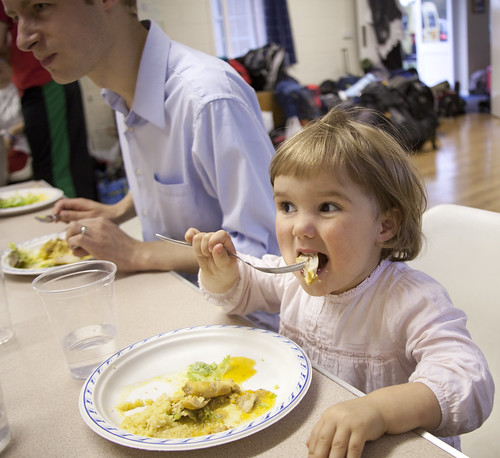
Something else which was noteworthy is that we were able to have Mass at the beginning of the day on the first two days, i.e. before breakfast. I understand that Mass used to be held on the Chartres Pilgrimage before leaving the camp, on the second day, but the numbers of pilgrims involved made it impractical to serve breakfast after Mass before marshaling everyone to leave.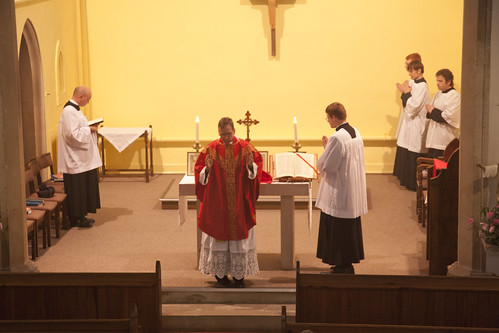
On Friday and Saturday we had Missa Cantata, on Sunday, in Walsingham, we had Solemn Mass. All were accompanied with chant, with a schola composed of pilgrims, and led by Matthew Schellhorn. We did pretty well, and as the pilgrimage continued Matthew added the use of drones to psalm verses, a very interesting, even exotic, effect.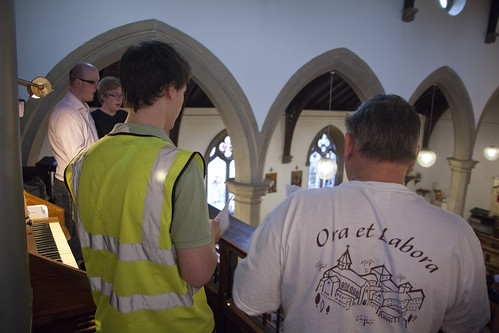
That's Tony Pead with his back to the camera above. As I've noted before, the Christus Rex pilgrimage in Australia, which he is involved with, was another important inspiration, and he came all the way to England to take part in the LMS Walsingham Pilgrimage.
Every time I visit Ely Cathedral, as we do to say prayers for the healing of schism and the conversion of heretics on the first morning, I find more to depress me about the destruction wreaked on the place by Protestantism. This is a small carving of the judgement of a soul, in what was the Cathedral's Chapter House. The scene is a conventional one so it is not difficult to see, even in its ruined state, what is going on. The chap with wings on the left is St Michael. The person in the middle would have been Our Lady, interceding for the poor sinner. The person on the right, near the front, is the soul being weighed in some scales; you can see the other scale, with a box in it representing the soul's good deeds. There is one face in this scene which has not been defaced: that of the devil, at the bottom, doing his best to drag the soul down to hell.
Christian dreadeth Christ that hath a newer face of doom,
And Christian hateth Mary that God kissed in Gallilee... (link)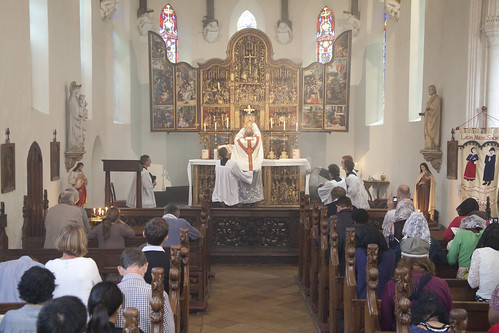
As always our Mass in Oxburgh Hall's private chapel is one of the highlights of the Pilgrimage. The house, a fantastic moated and crenelated manor house, preserved the Faith through all the ages of persecution, and when it became possible the Bedingfeld family built a chapel for the more worthy celebration of Mass. The Reredos is a late Medieval one from the Continent. The Bedingfelds are very hospitable and we had breakfast there as well.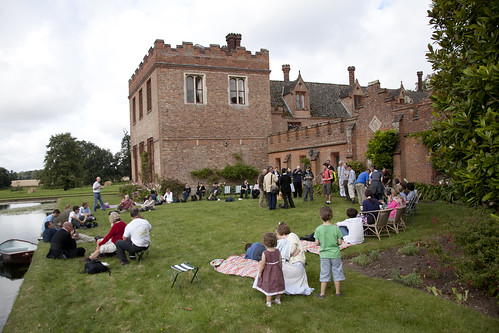
We visited the priest-hole they have, hidden under a loo, and marched off on the second day's walk.
Comes up along a winding road the noise of the crusade... (link)
Fr Bede has a number of good posts on the pilgrimage, done on the go: here and here, here and here, or just go to his blog and scroll down.
To be continued.

Something else which was noteworthy is that we were able to have Mass at the beginning of the day on the first two days, i.e. before breakfast. I understand that Mass used to be held on the Chartres Pilgrimage before leaving the camp, on the second day, but the numbers of pilgrims involved made it impractical to serve breakfast after Mass before marshaling everyone to leave.

On Friday and Saturday we had Missa Cantata, on Sunday, in Walsingham, we had Solemn Mass. All were accompanied with chant, with a schola composed of pilgrims, and led by Matthew Schellhorn. We did pretty well, and as the pilgrimage continued Matthew added the use of drones to psalm verses, a very interesting, even exotic, effect.

That's Tony Pead with his back to the camera above. As I've noted before, the Christus Rex pilgrimage in Australia, which he is involved with, was another important inspiration, and he came all the way to England to take part in the LMS Walsingham Pilgrimage.

Every time I visit Ely Cathedral, as we do to say prayers for the healing of schism and the conversion of heretics on the first morning, I find more to depress me about the destruction wreaked on the place by Protestantism. This is a small carving of the judgement of a soul, in what was the Cathedral's Chapter House. The scene is a conventional one so it is not difficult to see, even in its ruined state, what is going on. The chap with wings on the left is St Michael. The person in the middle would have been Our Lady, interceding for the poor sinner. The person on the right, near the front, is the soul being weighed in some scales; you can see the other scale, with a box in it representing the soul's good deeds. There is one face in this scene which has not been defaced: that of the devil, at the bottom, doing his best to drag the soul down to hell.
Christian dreadeth Christ that hath a newer face of doom,
And Christian hateth Mary that God kissed in Gallilee... (link)

As always our Mass in Oxburgh Hall's private chapel is one of the highlights of the Pilgrimage. The house, a fantastic moated and crenelated manor house, preserved the Faith through all the ages of persecution, and when it became possible the Bedingfeld family built a chapel for the more worthy celebration of Mass. The Reredos is a late Medieval one from the Continent. The Bedingfelds are very hospitable and we had breakfast there as well.

We visited the priest-hole they have, hidden under a loo, and marched off on the second day's walk.

Comes up along a winding road the noise of the crusade... (link)
Fr Bede has a number of good posts on the pilgrimage, done on the go: here and here, here and here, or just go to his blog and scroll down.
To be continued.
Thursday, September 06, 2012
Bishop Davies: what did he say to the LMS?
To book as a pilgrim for next year, at this year's rates, go the LMS Website
and take advantage of the Early Bird offer. The dates for 2013 will be
the equivalent of this year's, i.e. the bank holiday weekend: Friday
22nd to Sunday 25th August 2013.
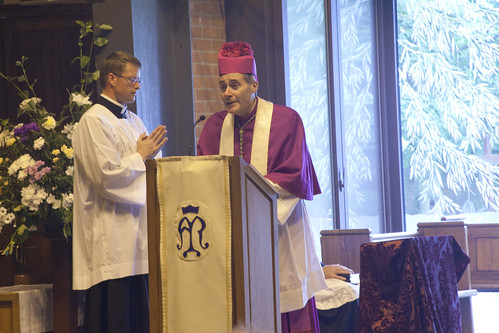
Our old friends at The Tablet have attempted to portray Bishop Davies' sermon at the LMS Pilgrimage to Walsingham as a sort of call to us to maintain, or even adopt, the orthodoxy represented by the Second Vatican Council:
'The Bishop of Shrewsbury, Mark Davies, has called on the Latin Mass Society (LMS) to pass on the faith according to the Second Vatican Council, writes Sam Adams.' (Tablet, 1st Sept, p30)
Well we have news for Sam Adams: the truth is more interesting. Bishop Davies explores, at the end of his sermon, what exactly the Council was supposed to be about, and stresses that 'we' - fellow pilgrims to Walsingham - must keep that in mind, and by implication not heed the 'hermeneutic of rupture', the claim that the Council justified every kind of rejection of tradition. Rather, the Council was intended to pass on the Faith - the Faith of the Church, preserved by Tradition - in its integrity. The idea that Bl. Pope John XXIII, whose face (with tiara) adorns every edition of The Tablet in an advert for the ludicrous group 'Catholics for Vatican II', would have wanted to jettison whole planks of the faith, or major parts of the ancient liturgy, is absurd, and completely incompatible both his words and with what we know of him as a man.
Bishop Davies' call for us to do what Bl. Pope John XXIII wanted, that is, to pass on the Faith in its fullness, in ways best adapted to reach the people of our day as effectively as possible, is one readily accepted by the Latin Mass Society and all traditionalists. On the 15th of this month I will be publishing a Position Paper on the Extraordinary Form and Western Culture, which explores exactly how the ancient Mass is suited to aid the evangelisation of the post-Christian culture in which we find ourselves.
The full text of Bishop Davies' sermon is on his diocese's website. Since it is not long, I reproduce it here with added emphases.
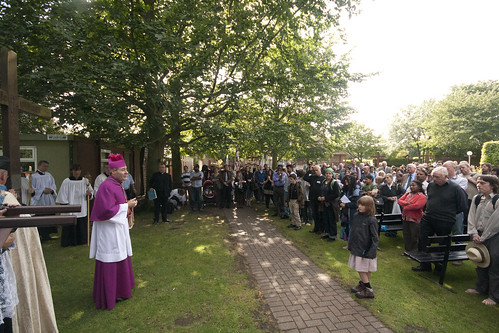
“When England returns to Walsingham Our Lady will return to England,” under the title of those words of Pope Leo XIII, which have inspired this pilgrimage, you have returned to Walsingham today. Returned like the solitary leper in the Gospel today to “give glory to God” for the gift of the Catholic faith we share, for the grace of all the Sacraments which have brought us a cleansing and new life infinitely more wonderful than the healing of those ten lepers, and above all for this Most Blessed Sacrament of the Eucharist. At the centre of “England’s Nazareth” built to recall the joy of the angelic salutation, the very joy of the Incarnation was not a statue but always an Altar. The scholar Erasmus provides us with a description of the Holy House on the eve of the Shrine’s destruction: “panelled with wood, having little light but that of the tapers,” he wrote “and glistening within with the reflection of gold, silver and precious stones. Inside, there was altar, usually with a Canon in attendance, and the figure of Our Lady stood at the right end of the altar in a dark corner.” The light which was extinguished here in Walsingham was not only England’s renowned devotion to Our Lady but the light of that flame which pointed night and day to the Real Presence of Our Lord, truly God and Man, in the Blessed Sacrament of the Eucharist. So it is with a renewed devotion to the Mother of God and our Mother too that we return here with thankful hearts to the Altar of God where the joy of the Church’s youth is ever renewed (Antiphon for Psalm 42).
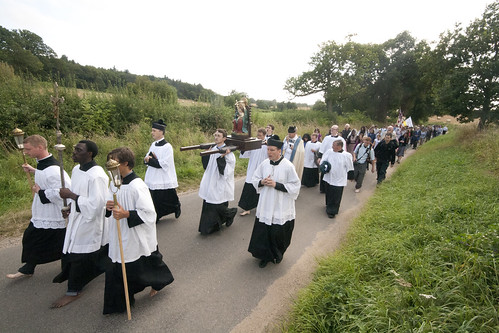
Even on a Holiday Weekend it is hard for us now to imagine the number of pilgrims who once came along these pathways to Walsingham. The East London site of the Olympic Games has briefly been the focus of global attention, filled with hundreds of thousands of athletes and visitors and will soon stand strangely empty? Walsingham was once the focus of world attention and not just for a fortnight but across the course of centuries. So many came to this remote corner of Norfolk it was lyrically suggested the constellation of the stars pointed the way to Walsingham! Yet those who come for the first time to England’s National Shrine quickly realise they have come to somewhere that was left in ruins! The tiny chapel, the slipper chapel is all that now remains of England’s “Nazareth,” a centre of pilgrimage once renowned alongside Jerusalem and Rome. The ferocity of its destruction, its rapid passing from memory would cause a ballad to lament, “Walsingham is no more!” Yet Walsingham has once again become a place of pilgrimage and hundreds of thousands have returned.
These very ruins of Walsingham towards which you will walk the last “Holy Mile” of this Pilgrimage serve to remind us that each successive generation must make that choice for the faith again. Much as we saw a flame, which was only a flame, passing from hand to hand across the country so something greater “the flame of faith” must be passed on from generation to generation. In October this year our Holy Father Pope Benedict invites us to celebrate a “Year of Faith,” fifty years after the solemn opening of the Second Vatican Council. The central aim of the Council was this transmission of the Church’s faith amid the new and rapidly changing conditions of our time. “The greatest concern of the Ecumenical Council” Blessed John XXIII declared on that October day, “is this, that the sacred deposit of Christian doctrine should be guarded and taught more efficaciously” (Address at the Opening of the Second Vatican Council 11th October 1962). In his Apostolic Letter Porta Fidei Pope Benedict invites us to celebrate both the opening of the Council and the publication twenty years ago of “The Catechism of the Catholic Church” as its authentic fruit. “We want this Year to arouse in every believer,” the Holy Father writes “the aspiration to profess the faith in fullness and with a renewed conviction, with confidence and hope. It will also be a good opportunity to intensify the celebration of the faith in the liturgy, especially in the Eucharist, which is (as the Council taught in Sacrosanctum Concilium 10) “the summit towards which the activity of the Church is directed … and also the source from which all its power flows” (Porta Fidei 9).

As the Latin Mass Society, as the faithful attached to the Extraordinary Form of the Roman Rite, as pilgrims to Walsingham we accept together with enthusiasm the call of the Second Vatican Council in all its authentic teaching and the invitation of this “Year of Faith” to which the Holy Father calls the whole Church. In this way we must seek not only to guard the deposit of faith but teach it more effectively, intensify the celebration of the faith in the Sacred Liturgy and bear witness to this faith in our whole lives. In this way we will pass on the flame of faith and so leave to new generations not the ruins of a Christian past but the faith which Walsingham has represented for almost a thousand years: the joy of the angelic salutation, the joy of the Word made flesh, the joy of the Blessed Sacrament of the Altar which Our Lady desired should never be lost in this land
Pray for us, O Most Holy Mother of God,
that we may be made worthy of the promises of Christ.

Our old friends at The Tablet have attempted to portray Bishop Davies' sermon at the LMS Pilgrimage to Walsingham as a sort of call to us to maintain, or even adopt, the orthodoxy represented by the Second Vatican Council:
'The Bishop of Shrewsbury, Mark Davies, has called on the Latin Mass Society (LMS) to pass on the faith according to the Second Vatican Council, writes Sam Adams.' (Tablet, 1st Sept, p30)
Well we have news for Sam Adams: the truth is more interesting. Bishop Davies explores, at the end of his sermon, what exactly the Council was supposed to be about, and stresses that 'we' - fellow pilgrims to Walsingham - must keep that in mind, and by implication not heed the 'hermeneutic of rupture', the claim that the Council justified every kind of rejection of tradition. Rather, the Council was intended to pass on the Faith - the Faith of the Church, preserved by Tradition - in its integrity. The idea that Bl. Pope John XXIII, whose face (with tiara) adorns every edition of The Tablet in an advert for the ludicrous group 'Catholics for Vatican II', would have wanted to jettison whole planks of the faith, or major parts of the ancient liturgy, is absurd, and completely incompatible both his words and with what we know of him as a man.
Bishop Davies' call for us to do what Bl. Pope John XXIII wanted, that is, to pass on the Faith in its fullness, in ways best adapted to reach the people of our day as effectively as possible, is one readily accepted by the Latin Mass Society and all traditionalists. On the 15th of this month I will be publishing a Position Paper on the Extraordinary Form and Western Culture, which explores exactly how the ancient Mass is suited to aid the evangelisation of the post-Christian culture in which we find ourselves.
The full text of Bishop Davies' sermon is on his diocese's website. Since it is not long, I reproduce it here with added emphases.

“When England returns to Walsingham Our Lady will return to England,” under the title of those words of Pope Leo XIII, which have inspired this pilgrimage, you have returned to Walsingham today. Returned like the solitary leper in the Gospel today to “give glory to God” for the gift of the Catholic faith we share, for the grace of all the Sacraments which have brought us a cleansing and new life infinitely more wonderful than the healing of those ten lepers, and above all for this Most Blessed Sacrament of the Eucharist. At the centre of “England’s Nazareth” built to recall the joy of the angelic salutation, the very joy of the Incarnation was not a statue but always an Altar. The scholar Erasmus provides us with a description of the Holy House on the eve of the Shrine’s destruction: “panelled with wood, having little light but that of the tapers,” he wrote “and glistening within with the reflection of gold, silver and precious stones. Inside, there was altar, usually with a Canon in attendance, and the figure of Our Lady stood at the right end of the altar in a dark corner.” The light which was extinguished here in Walsingham was not only England’s renowned devotion to Our Lady but the light of that flame which pointed night and day to the Real Presence of Our Lord, truly God and Man, in the Blessed Sacrament of the Eucharist. So it is with a renewed devotion to the Mother of God and our Mother too that we return here with thankful hearts to the Altar of God where the joy of the Church’s youth is ever renewed (Antiphon for Psalm 42).

Even on a Holiday Weekend it is hard for us now to imagine the number of pilgrims who once came along these pathways to Walsingham. The East London site of the Olympic Games has briefly been the focus of global attention, filled with hundreds of thousands of athletes and visitors and will soon stand strangely empty? Walsingham was once the focus of world attention and not just for a fortnight but across the course of centuries. So many came to this remote corner of Norfolk it was lyrically suggested the constellation of the stars pointed the way to Walsingham! Yet those who come for the first time to England’s National Shrine quickly realise they have come to somewhere that was left in ruins! The tiny chapel, the slipper chapel is all that now remains of England’s “Nazareth,” a centre of pilgrimage once renowned alongside Jerusalem and Rome. The ferocity of its destruction, its rapid passing from memory would cause a ballad to lament, “Walsingham is no more!” Yet Walsingham has once again become a place of pilgrimage and hundreds of thousands have returned.
These very ruins of Walsingham towards which you will walk the last “Holy Mile” of this Pilgrimage serve to remind us that each successive generation must make that choice for the faith again. Much as we saw a flame, which was only a flame, passing from hand to hand across the country so something greater “the flame of faith” must be passed on from generation to generation. In October this year our Holy Father Pope Benedict invites us to celebrate a “Year of Faith,” fifty years after the solemn opening of the Second Vatican Council. The central aim of the Council was this transmission of the Church’s faith amid the new and rapidly changing conditions of our time. “The greatest concern of the Ecumenical Council” Blessed John XXIII declared on that October day, “is this, that the sacred deposit of Christian doctrine should be guarded and taught more efficaciously” (Address at the Opening of the Second Vatican Council 11th October 1962). In his Apostolic Letter Porta Fidei Pope Benedict invites us to celebrate both the opening of the Council and the publication twenty years ago of “The Catechism of the Catholic Church” as its authentic fruit. “We want this Year to arouse in every believer,” the Holy Father writes “the aspiration to profess the faith in fullness and with a renewed conviction, with confidence and hope. It will also be a good opportunity to intensify the celebration of the faith in the liturgy, especially in the Eucharist, which is (as the Council taught in Sacrosanctum Concilium 10) “the summit towards which the activity of the Church is directed … and also the source from which all its power flows” (Porta Fidei 9).

As the Latin Mass Society, as the faithful attached to the Extraordinary Form of the Roman Rite, as pilgrims to Walsingham we accept together with enthusiasm the call of the Second Vatican Council in all its authentic teaching and the invitation of this “Year of Faith” to which the Holy Father calls the whole Church. In this way we must seek not only to guard the deposit of faith but teach it more effectively, intensify the celebration of the faith in the Sacred Liturgy and bear witness to this faith in our whole lives. In this way we will pass on the flame of faith and so leave to new generations not the ruins of a Christian past but the faith which Walsingham has represented for almost a thousand years: the joy of the angelic salutation, the joy of the Word made flesh, the joy of the Blessed Sacrament of the Altar which Our Lady desired should never be lost in this land
Pray for us, O Most Holy Mother of God,
that we may be made worthy of the promises of Christ.
Wednesday, September 05, 2012
Bishop Davies visits SS Peter & Paul, New Brighton
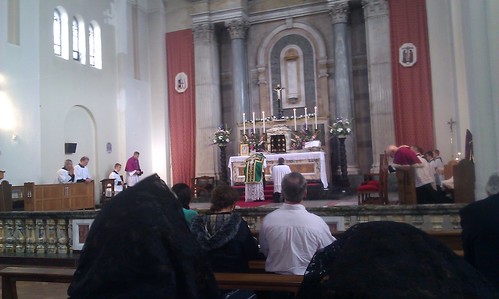
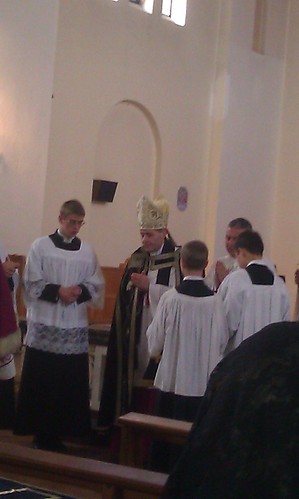 Above: Canon Meney saying Mass, with Bishop Davies in choir.
Above: Canon Meney saying Mass, with Bishop Davies in choir. On Sunday 2nd Bishop Davies made a pastoral visit to the shrine church of SS Peter & Paul and St Philomena, in New Brighton. I hadn't realised how in the 1962 books when a bishop visits a parish, formally, there are special ceremonies and blessings, notably for the deceased of the parish.
I wasn't present myself at this ceremony, but it is good to see a bishop taking seriously his paternal concern for his parishes.
There are a couple more photos here.
Off to the Highlands
Tuesday, September 04, 2012
Successful Pilgrimage to Our Lady of the Taper
The Celebrant was Rt Rev Mgr Canon Johnson the MC was the young Seamus Hargrave.
The LMS rep Luigi Dimaio made a presentation from LMS members and supporters to Mgr Canon Johnson after Mass, in recognition for all his work over the last 20 years in providing the Traditional Latin Mass in Menevia. He will be retiring in October.
The LMS rep Luigi Dimaio made a presentation from LMS members and supporters to Mgr Canon Johnson after Mass, in recognition for all his work over the last 20 years in providing the Traditional Latin Mass in Menevia. He will be retiring in October.
LMS Pilgrimage to Glastonbury, Sat 8th
 Glastonbury Abbey is where you'll find the Holy Thorn, planted by St Joseph of Arimathea, the grave of King Arthur, and the site of martyrdom of the last Abbot, Bl Richard Whiting. Not bad for one place!
Glastonbury Abbey is where you'll find the Holy Thorn, planted by St Joseph of Arimathea, the grave of King Arthur, and the site of martyrdom of the last Abbot, Bl Richard Whiting. Not bad for one place!A Low Mass will be celebrated at 11am on Saturday 8th September for the Feast of the Nativity of the Blessed Virgin Mary in the crypt chapel of the ruined Abbey of St Mary at Glastonbury.
Arrangements
have been made with the Abbey authorities to admit anyone attending
this Mass into the Abbey grounds free of charge. There is a car park
next to the Abbey.
See Clifton LMS blog.
Monday, September 03, 2012
Old Rite Requiem for Fr Thwaites
This will be said by his fellow Jesuit Fr John Edwards in the famous Jesuit Church, the Immaculate Conception Farm Street, (114 Mount Street, City of Westminster, W1K 3AH)
2pm, Tuesday 11th September. Map
Here's Gloria TV News on the controversy over the Jesuits' arrangements for his funeral. This Requiem to be celebrated by Fr Edwards will be the first Traditional Mass to be said in Farm Street, as far as we know, since 1970, so something good has come out of it! Fr Hugh Thwaites may be smiling about this from his new perch above...
2pm, Tuesday 11th September. Map
Here's Gloria TV News on the controversy over the Jesuits' arrangements for his funeral. This Requiem to be celebrated by Fr Edwards will be the first Traditional Mass to be said in Farm Street, as far as we know, since 1970, so something good has come out of it! Fr Hugh Thwaites may be smiling about this from his new perch above...
Sunday, September 02, 2012
Change of rector for SS Peter & Paul in the Wirral
It has been anounced that Canon Meney ICKSP will be succeeded by Canon Amaury Montjean ICKSP.
The announcement included the following text: "This unforseen change had to be decided because of a sudden and very grave illnes of one of our Canons in the United States. Since Canon Meney has long experience in North America, he is urgently needed in this difficult moment to help with the necessary replacement." His last Mass in SS Peter & Paul will be on 16th September.
We will miss Canon Meney, whose energy and enthusiasm were infectious, but we wish him well for his new role in San Fransisco and look foward to meeting his successor. Please pray for the continued success of the Institute's apostolate in the Wirral.
 |
| Canon Meney on the LMS Walsingham Pilgrimage |
We will miss Canon Meney, whose energy and enthusiasm were infectious, but we wish him well for his new role in San Fransisco and look foward to meeting his successor. Please pray for the continued success of the Institute's apostolate in the Wirral.
Manchester Oratory to be established!
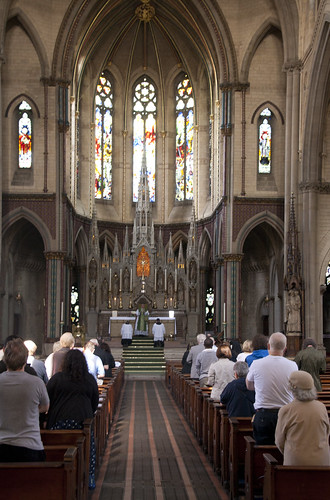 |
| EF Low Mass at the Holy Name |
Sadly they will be moving away from the Holy Name, which has been their home for ten years. The Jesuits, perhaps surprisingly, are returning to it, and will be running the University Chaplaincy as well. But the Oratorian community are being given another church in Manchester: St Chad's, Cheatham Hill.
Fr Matus' confrere Br Richard Bailey was the second tutor at the Latin Mass Society's Latin Course at Pantasaph in Wales this Summer.
Here is the announcement on the Diocese's website; and on the Holy Name website, which I also reproduce below.
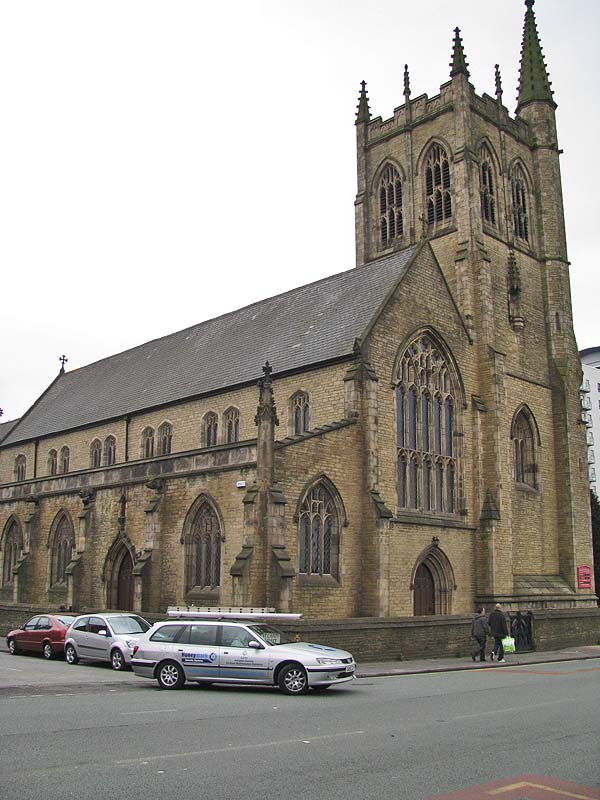 |
| St Chad's Cheatham Hill |
With great thanksgiving to Almighty God, our Blessed Lady and our Holy Father St Philip, we can announce that the Bishop of Salford given his approval for the erection of the Congregation of the Oratory of St Philip Neri in Manchester.
The Manchester Oratory will be close to the city centre at St Chad’s, Cheetham Hill, which is the Mother Church of the City.
We will continue to be at the Holy Name until Advent, or when arrangements have been finalised.
The Holy Name will then be part of the Chaplaincy to the Universities on Oxford Road staffed by the Society of Jesus.
A Letter from His Lordship will be read the weekend of 1st / 2nd September to the Congregations at the Holy Name and St Chad’s.
Please keep us in your prayers at this time.
Following the canonical erection of the Sons of the Most Holy Redeemer on Papa Stronsay, just a few days ago, which had also been long delayed, this news gives me great joy. I feel as though the ice sheet of immobility which has been covering the Catholic Church in the UK, preventing the most promising things from growing, is finally cracking, and water is flowing again. If new apostolates, new religious communities seeking the recovery of tradition, are allowed to establish themselves and develop, then we can begin to think, not about managing the decline of the Church in our country, but actually of re-evangelising it.
Subscribe to:
Comments (Atom)



